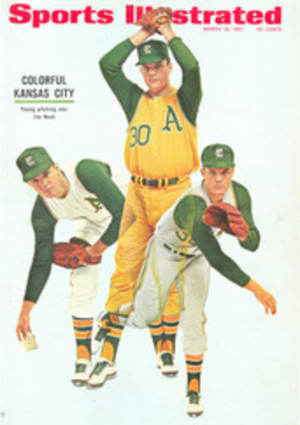
For sportsmen pilots, paradise can be found just this side of Half-Swacked Bay
As any islomane will tell you, the mystique of an island is its snug contentment, removed from all the flaps and frustrations of the nutty world outside. In the San Juan Archipelago off the northwest coast of Washington, there is an island called Blakely which, because it combines insularity with easy accessibility, has emerged as a kind of paradise for the sports flying fraternity.
Blakely is an odd mixture of tame deer, contented sea otters, absolute wilderness and the best-lighted all-weather landing strip in the San Juan Islands. Bill Beebe, a Bellevue businessman, sums up its appeal when he confides, "The minute my wheels touch down on the island I become a different person. I flew my stockbroker in last weekend, and after I flipped off the engine I told him, 'Listen.' 'Listen to what?' he asked me. 'Listen to nothing,' I replied. 'Just listen to nothing.' "
Blakely is a private island with just enough public facilities to make stray boaters and flyers feel reasonably welcome. There is the Skytel (a motel for people down out of the sky), a clubhouse with bar and restaurant, a boat marina fully equipped to care for around 60 visiting yachts, a 40-foot motor sailer for charter, and that 2,400-foot, grass-planted, lighted landing field extending across the northwest corner of the island from Peavine Pass to Half-Swacked Bay. The bay, incidentally, was named by early-day loggers in tribute to somebody who fell in, and doesn't refer to habits of the current islanders. Blakely is at its liveliest any time from late April until the first real knockdown storm of autumn, say in mid-October. Yet to escape the harsh winter climate east of the Cascades Range, a small colony of dry-land Oregon and Washington flying wheat ranchers lives on Elakely throughout the winter months, when their mainland empires are frozen.
The sixth largest body of land in the San Juan Islands, Blakely measures about 10 square miles. It was purchased in 1954 by Floyd Johnson, an early sports flyer and onetime international salesman for Cessna. Floyd, at that time manager of the Columbia Aviation Club in Portland, Ore., had spent years searching by air from Mexico to the Canadian line for a flyers' rendezvous on the West Coast. The club had a nebulous idea of purchasing such a spot for its fly-ins, but when Floyd proposed a 5,000-acre island, the venture was considered too ambitious.
The club dropped out of the deal and the Johnsons, Floyd and Ola, took over. An island that had lain fallow for decades following the departure of families of 19th century homesteaders, who once operated a little pioneer lumber mill near the island's southern tip, Blakely had everything—two spring-fed high mountain lakes for trout fishing and plentiful water supply, a flattened area at the northwest corner for the landing strip, a natural yacht basin that needed only dredging, more than 17 miles of exquisite beaches and sandspits and coves and precipitous cliffs dropping into the sea. The island was richly furred with second-growth forest, sprung up after the logging of 80 years ago in the deep glacial silt left behind by the melting of Puget Glacier in the last Ice Age.
Best of all from a flyers standpoint, it lay in the very center of the Banana Belt, an area which receives only half the rainfall of the Washington mainland. Happily, the San Juans are set in an amphitheatre of great mountain ranges—Canada's Vancouver Island mountains on the west and Coast Ranges to the north, the Cascades on the east side of the bowl and the Olympic Mountains to the south. Rain-bearing westerlies suffer their first big squeeze as they run this gantlet. The clouds mass again against the Cascades, but in the geographic interval storms are dispersed and the islands bask in sun while mainlanders glower out at them from under downpour. Temperatures run 10 degrees warmer in the isles.
Because of all this, some developers descend on the San Juan Islands with the zeal of a French chef on a bundle of parsley, hacking them up into the greatest possible number of homesites and planting fluorescent property markers up and down anything a goat can climb. But the Johnsons were in love with the wilderness beauty of Blakely, and equally touched by its reminders of pioneer life—split-rail fences thick and green with moss, a moldering log school-house, gnarled fruit orchards grown from slips set out by homesteaders' wives, crumbling log barns and cabins and even a bathtub carved for a bride from a single cedar log. They decided to leave the bulk of its 5,000 acres just as they were, developing a mere 200 acres in the vicinity of the landing strip for a maximum of 150 flying and boating families. They brought in a power cable from the mainland and telephone service—but left the pioneer wagon roads in the interior of the island just about as they found them.
"If we put in good roads, people would insist on bringing cars to Blakely. This way they confine themselves to a jeep or two per family, and bicycles," says Floyd. The end result is a "wild" island for the enjoyment of settlers, and a sophisticated colony of congenial people who appreciate it. Some 3,000 deer, all that island browse will maintain, bald eagles that have nested in ancient snags near the shores of Horseshoe and Spencer lakes for generations, sea otters romping along the beaches and a colony of blue herons remain undisturbed.
Sports flyers spread the news of the island marina nationwide in no time at all. On a summer weekend, Blakely's strip has been known to log more landings than Seattle's Boeing Field 80 miles to the south. They come in like homing butterflies from all over the continent—Mexican sportsmen fascinated with Puget Sound skin diving, New York businessmen attracted by the peace and privacy, Alaskans lingering over on a trip "outside," California lettuce kings and Hawaiian hotelmen, salmon-fishing motion-picture actors and Chicago novelists. You meet everybody at Blakely sooner or later.
Still, it is not in the least pretentious. Expenditure for such improvements as the landing strip and yacht basin has been lavish, but the clubhouse is World War II surplus housing that was hauled to the island by landing barge back in the early days of Blakely development. Modest A-frame vacation houses are tucked in the woods quite comfortably beside elegant year-round homes. Blakely's idea of a real good party is a jug of martinis and a smoked salmon, consumed on the summit rocks of Blakely Peak as the sun drops into the low-lying fogbank that lurks just west of Vancouver Island.
Islanders don't ring doorbells to find out who's in—they check planes on the parking strips fanned out into the trees. Businessmen of Bellevue and Seattle learned long ago that it makes more sense to commute by plane from office to Blakely than to face the freeway frolic. The bonus is the bliss of children turned loose to explore an entire island of wild, driftwood-decked beaches and soaring sun-bleached rocks reaching over a thousand feet in height.
Oldtimers in the San Juan Islands, who take a dim view of almost any development, look upon the Johnsons' discreet stewardship of Blakely Island with approval. Once I took a California realtor to Blakely for a look. In Floyd's office on the ground floor of the clubhouse there is a huge aerial photograph of the island that shows the planned residential area taking up something like [1/25] of the whole—a testament to taste and restraint.
"Why, you don't develop these islands at all!" the Californian protested finally, studying all that wildlife sanctuary. "You just choose a corner and live on it!"
And that's what Blakely is all about—a private pilots' rendezvous and colony without equal on the Pacific Coast. Rachel Field wrote of islands in general: "Once you have slept on an island/You'll never be quite the same."
This might be amended for flyers. Once they've buzzed Blakely's deer off the strip and homed in on the island, they're never quite the same.

